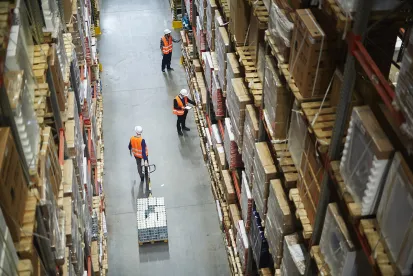Companies in the manufacturing industry who wish to address the “S” in ESG can start by addressing human rights compliance in their supply chains. While some firms are far along in this journey, many are just getting started. For those in the latter category, we recommend that you follow these initial steps: (1) conduct a supply chain human rights risk assessment, (2) conduct human rights compliance due diligence on high-risk suppliers, (3) add appropriate human rights compliance language to your supply agreements, and (4) develop a human rights monitoring and auditing program. Proactively taking these steps now is all the more important, considering the current strain on supply chains due to global events, component shortages, and ever-increasing regulatory and enforcement scrutiny.
1. Risk Assessment
To begin, compile a list of your company’s 20 largest suppliers and organize them by location, the type of goods they supply to you, and the cost. Next build a basic, but reasonable, risk heat-map, which assesses the likelihood of a human rights violation and the adverse impact such a violation could have on the business. Doing so allows you to identify those suppliers who might expose your company to legal liability or reputational damage associated with human rights violations. The factors described below are a good place to start, although others may be relevant depending on the nature of your business.
Begin with a jurisdictional analysis. Countries that pose a higher risk of tolerating child or forced labor can be fairly easily identified using public information:

Next, look at the industry in which your supplier operates. What type of products are you purchasing from them, and what are the history and risks of human rights violations historically associated with that industry?

To visualize this data as a risk heat-map, we combined these two criteria, and blended the data with Global Slavery Index data on prevalence of modern slavery. The resulting map is below:

2. Due Diligence
Once high-risk suppliers have been identified, you should conduct some compliance-focused due diligence on them to further probe the risk of human rights violations in your supply chain. Here, many manufacturing companies will already have a serviceable template from which to start: the process used to evaluate third-party intermediaries for purposes of complying with anti-corruption laws, such as the Foreign Corrupt Practices Act (FCPA) or U.K. Bribery Act (2010). The process for identifying forced and child labor risks in a company’s supply chain can be similar, even though the substance and context are different. Basic due diligence tools include:
Human Rights Compliance Questionnaires: Requiring suppliers to complete a detailed questionnaire is one way to obtain information helpful in assessing the likelihood of human rights risks in your supply chain. Some model questions that can be used for most suppliers are included as:
-
Do you have a human rights compliance policy?
-
What specific policies or practices are in place to address human rights risks (including modern slavery, illegal child labor, and human trafficking)?
-
How do you assess and/or manage risk associated with human rights issues?
-
Who or what function is responsible for overseeing compliance, with policies addressing human rights issues?
-
What procedures do you employ to check the ages and confirm the identities of your employees?
-
Have you been the subject of any government investigation or audit relating to your labor practices?
-
Have you been the subject of any fines or penalties from any government authority, relating to your labor practices?
-
What, if any, due diligence do you perform on your suppliers or third parties to address human rights issues?
-
Are your facilities located in countries with a reputation for human rights violations?
-
Do you subcontract any manufacturing to entities located in countries with a reputation for human rights violations?
-
Do you procure any product components from entities located in countries with a reputation for human rights violations?
-
When contracting with third parties, do you include terms and conditions and other standard contractual provisions that address compliance with respect to human rights issues?
-
How are instances of noncompliance with your compliance policies addressed?
Reputational Report: Commissioning a background report on higher-risk suppliers can enable you to vet answers provided in response to questionnaires as well as identify prior associations with human rights violations (or violators), government enforcement actions, or other issues or reports that adversely reflect on the supplier’s reputation.
Red Flag Follow-Up: Investigating any red flags identified in either the questionnaire responses or the background report is a must. For example, a supplier might, without engaging in due diligence, purchase product components from manufacturers in countries with a reputation for human rights violations. Red flags such as these do not mean that you cannot work with the supplier; investigate the issues to determine the appropriate way to proceed. Flags come in varying shades of red, and determining the appropriate response requires following up to better understand the facts and circumstances and, potentially, to engage in specific remediation.
3. Contractual Clauses
A lot of compliance starts and ends with contractual clauses, because these are sometimes the best (or only) leverage companies have with suppliers. We view proactive risk mitigation through thoughtful contracting as obviously necessary (though clearly not sufficient). Good contracts will address the following issues:
-
Inclusion of appropriate representations and warranties that the supplier is abiding by all applicable human rights laws;
-
Requirement that suppliers maintain or adopt reasonable and appropriate human rights compliance measures; and
-
In appropriate circumstances, a requirement that the supplier permit periodic audits of relevant documents, records, obligations, and creation of audit rights.
The American Bar Association’s Business Law Section has drafted a set of Model Contract Clauses to guard against human rights abuses in international supply chains. Manufacturers should review these provisions and consider inclusion of them when contracts with suppliers are renewed or when establishing relationships with new suppliers.
4. Monitoring & Auditing Program
The last step is the most challenging. For a human rights compliance program to be taken seriously, it must include some form of continuous monitoring, supported by periodic audits. At a minimum, manufacturers should require high-risk suppliers to regularly certify compliance, reengage in due diligence of suppliers on a periodic basis, subject selected suppliers to periodic audits, and include training on relevant laws or company policies. Some hallmarks of a monitoring and evaluation program are detailed in the UN’s Guide to Supply Chain Sustainability:
-
Supplier Self-Assessment: Self-assessments, which can involve similar questions to those detailed in the questionnaire described in Section 2, can identify suppliers that have improved their human rights compliance practices, as well as those that may require additional scrutiny. At the least, self-assessments can reinforce, for suppliers, a company’s expectations with regard to human rights compliance.
-
Facility Tour: A visual inspection of a supplier’s factory can identify instances of noncompliance.
-
Records Review: This should involve review of compliance policies, health and safety records, and any subcontracts with suppliers.
-
Management Interview: Understanding senior management’s commitment to human rights compliance is critical to understanding any risk posed by a supplier.
-
Workforce Interviews: While management may be best positioned to speak about the supplier’s approach to compliance, the boots on the ground are often the best source to understand how that theory translates into practice (if it does).
Effective audits are expensive and time consuming. But here, too, companies can look to vendors for support, as quite a few now conduct ethical trade audits. Taken together, the foregoing four steps will jump-start your company’s supply chain compliance program and position you well to manage and mitigate risk. The sooner, the better.





 />i
/>i

